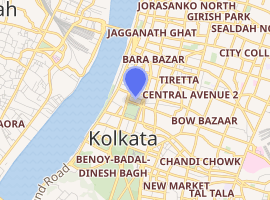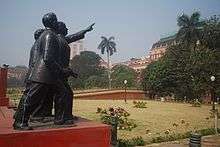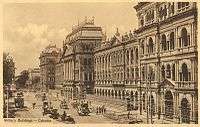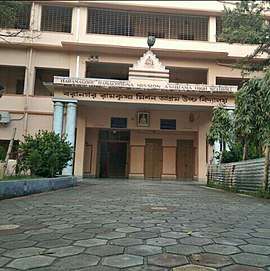Writers' Building
The Writers' Building, often shortened to just Writers', is the secretariat building of the State Government of West Bengal in India.[1] It is located in West Bengal's capital city of Kolkata. The 150-meter long building covers the entire northern stretch of the iconic Lal Dighi pond in the downtown area of B.B.D. Bagh.
| Writers' Building | |
|---|---|
 Main façade of the Writers' Building | |

| |
| General information | |
| Location | Lal Dighi, BBD Bagh, Kolkata – 700001 West Bengal |
| Construction started | 1777 |
| Owner | Government of West Bengal |
| Design and construction | |
| Architect | Thomas Lyon |
It originally served as the principal administrative office for writers (junior clerks) of the British East India Company. Designed by Thomas Lyon in 1777, the Writers' Building has gone through several extensions over the years. Since India's independence in 1947, it housed the office of the Chief Minister of West Bengal until 4 October 2013. The majority of government departments were subsequently moved out to another building named Nabanna in Howrah on a temporary basis for facilitating renovation.
The building has been called a mini-township of sorts with a built-up area of around 550,000 square feet. Before the shifting of the state secretariat, the building housed 34 departments and other offices of the state government, with approximately 6,000 employees.[2]
As of August, 2019, the renovation of the building continues.
History
The Writers' Building was designed by Thomas Lyon in 1777 for the British East India Company. In 1821 a 128 ft-long verandah with Ionic columns, each 32 ft high, were added on the first and second floors. From 1889 to 1906 two new blocks were added, approached by iron staircases that are still in use. Writers' acquired its Greco-Roman look, complete with the portico in the central bay and the red surface of exposed brick. The parapet was put in place and the statues sculpted by William Fredric Woodington in 1883, that line the terrace, were installed.[3]
The building was intended to be the effective headquarters of the East India Company in the Bengal province of the Mughal Empire.
Timeline

1776: The site of the demolished St Anne's church and the adjoining plot were granted to Thomas Lyon, after whom Lyons Range is named, to construct buildings to accommodate the junior servants of the East India Company called "writers". Lyon was acting on behalf of Richard Barwell, member of the council, when Warren Hastings was governor. Writers' Building was the first three-storey building in Calcutta.
1800: Fort William College, opened to train writers in Oriental languages, later moved to this building. Over the next 20 years, structural changes were made: a hostel for 32 students and an exam hall, which still exist, a lecture hall, four libraries and rooms to teach Hindi and Persian.
1821: A 128 ft-long verandah with Ionic columns, each 32 ft high, were added on the first and second floors.

1830: The college moved out of Writers' and the building fell into the hands of private individuals who turned it into living quarters, shops and godowns. The Government College of Engineering functioned from here for some time.
1871–74: George Campbell, lieutenant governor-general, felt the need for a secretariat for "quick disposal of work". But the East Indian Railway Company occupied a large space at Writers' and was unable to find alternative accommodation.
1877–82: Ashley Eden, lieutenant-governor of Bengal, was told to relocate the principal offices, housed on Sudder Street and Chowringhee, to Writers'. Because of the space crunch, initially three blocks were constructed.
1879–1906: Two new blocks were added, approached by iron staircases that are still in use. Writers' acquired its Greco-Roman look, complete with the portico in the central bay and the red surface of exposed brick. The parapet was put in place and statues sculpted by William Fredric Woodington in 1883 were installed lining the terrace. The statue of Minerva stands above the central portico.
Since 1947: At the time of independence in 1947, Writers' had a large courtyard with seven blocks. By 1970, all 13 blocks were constructed. But only the main block, including the rotunda and five main blocks, are heritage structures.[3]
Assassination of Colonel N.S. Simpson

On 8 December 1930 Benoy Basu, Badal Gupta and Dinesh Gupta, members of the underground revolutionary group Bengal Volunteers, headed for the Writers' Building. Dressed in European attire, they carried loaded revolvers. Upon entering the building, they shot dead the notorious Inspector General of Police, Colonel N.S. Simpson, infamous for his brutal oppression of political prisoners, most of whom were Indian freedom fighters.[4]
After killing him, they occupied the building, and soon a gun battle followed in the corridors. Unable to stand up to the numerous forces of the Calcutta police, the trio soon found themselves overpowered and cornered.
Unwilling to give themselves up, Badal took potassium cyanide and died instantly, while his comrades shot themselves. Benoy died five days later in hospital but Dinesh survived only to be hanged on 7 July 1931.

Today Dalhousie Square is named after the trio and is called B.B.D. Bagh. A statue of Benoy, Badal and Dinesh stands in front of the Writers' Building, showing Benoy, the group leader, leading his comrades in their final battle.[5]
Architecture
The giant pediment at the centre is crowned with the statue of Minerva. The terrace also contains several other statues and notable among them are four clusters of statues, christened 'Justice', 'Commerce', 'Science' and 'Agriculture', with the respective Greek gods and goddesses of these four disciplines (Zeus, Hermes, Athena and Demeter respectively) flanked by a European and an Indian practitioner of these vocations.[6]

Renovation
The building went under renovation in late 2013, in a project costing ₹2 billion (US$28 million). To facilitate this, the state Secretariat and Chief Minister's office temporarily shifted to an abandoned skyscraper owned by the Hooghly River Bridge Commissioners Office named Nabanna in Howrah.[7][8] In February 2014, the project was stalled after conservation experts and the state Public Works Department found the plan submitted by an architect firm insufficient.[9] Meanwhile, a team of Jadavpur University and Indian Institute of Engineering Science and Technology, Shibpur architects was invited to conduct tests of the structure, before the actual renovation could be started.[10]
The renovation efforts also involved the Indian National Trust for Art and Cultural Heritage (INTACH). The team had also sought consultations with heritage conservationists from countries like Australia and Germany before submitting a detailed proposal in late-2015. But even by mid-2016, work on ground had not started due to government indecisiveness and bureaucratic red tape.[11]
Engineers had to fortify the structure before the East West Metro Tunnel, part of the expansion of the Kolkata Metro, was dug past the building in November-2017.[12]
Tenders for civil engineering work in various parts of the main structure were being issued as of end-2018. [13]
Picture gallery
 The original building with Holwell's Blackhole incident monument in the background
The original building with Holwell's Blackhole incident monument in the background Writers' Building, c. 1915
Writers' Building, c. 1915 Pre-independence photograph of the facade
Pre-independence photograph of the facade_by_Francis_Frith.jpg) Writers Buildings, Calcutta (Second view)
Writers Buildings, Calcutta (Second view)_by_Francis_Frith.jpg) Writers Buildings, Calcutta (Third view)
Writers Buildings, Calcutta (Third view)_by_Francis_Frith.jpg) Writers Buildings, Calcutta (Fourth view)
Writers Buildings, Calcutta (Fourth view)
References
- "Mamata Banerjee walks full distance from log cabin to Writers' Building". The Times of India. 14 May 2011.
- "Kolkata's iconic Writer's Building gets ready for a facelift". The Weekend Leader. 4 October 2014. Retrieved 19 August 2019.
- Das, Soumitra (20 May 2011). "Writ of Writers'". The Telegraph. Calcutta, India. Retrieved 19 January 2012.
- Agrawal, Lion M. G. (2008). Freedom fighters of India. Gyan Publishing House. ISBN 9788182054707.
- Ghosh, Durba (20 July 2017). Gentlemanly Terrorists: Political Violence and the Colonial State in India, 1919–1947. Cambridge University Press. ISBN 9781107186668.
- Mazumdar, Jaideep (13 September 2012). "Kolkata walk: Tracing the heritage footsteps of the Raj". Times of India. Retrieved 19 January 2012.
- "Writers' Buildings temporarily dethroned as West Bengal's seat of power – The Hindu". 5 October 2013. Retrieved 28 February 2014.
- "Mamata Banerjee moves to Howrah's HRBC from Writers' Buildings". Economic Times. 5 October 2013. Retrieved 28 February 2014.
- "Writers' revival plan 'flawed'". The Times of India. 19 February 2014. Retrieved 28 February 2014.
- "Tests for Writers' Buildings before restoration". The Times of India. 4 February 2014. Retrieved 28 February 2014.
- "Writers' Buildings renovation yet to start even after three years". Business Standard. 24 May 2016. Retrieved 19 August 2019.
- "Writers' clears tunnel test". Business Standard. 11 November 2017. Retrieved 19 August 2019.
- "Tender for electrical work at Writer's Building". 16 November 2018. Retrieved 19 August 2019.
External links
| Wikimedia Commons has media related to Writers' Building. |
